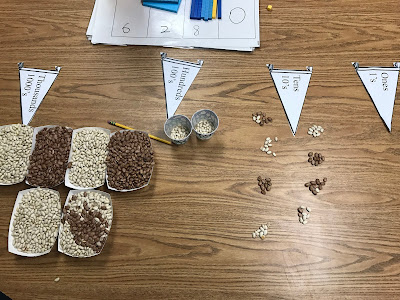We're invited to help solve a king-sized problem!
Lady Maitlen and Lady Towne, the second and first grade teachers at Seabury School, regularly gather all our students together for some real life, hands-on, challenging, fun, open-ended math adventures. We often start with a question and a challenge and let the students discover, through trial and error, the mathematical concept we are introducing.
This type of activity elicits great mathematical thinking and conversations and allows for the students to work at their unique individual level. It also fosters collaboration and a sense that math really matters. The words in quotation marks below are snippets from actual conversations.
In our first Great Quest of the year, the students will discover a better way to count big amounts by using place value.
After receiving the invitation above and reading the first part of the book, Sir Cumference and All the King's Tens, the students are up for the challenge and begin counting beans, each bean representing one person.
With that challenge in mind, we break into groups of three and started counting our beans. We discover right away that this is going to take FOREVER.
"147, 148, 149..."
This student's group has a great idea...but unfortunately they lose count.
"We know how to count by 10's."
"It's faster to count by 10's than 1's."
"When we added them all up it got mixed up and we had to start all over again."
"Maybe if we write it down."
"We should just use a calculator."
"I actually like counting."
This group decide to divide their beans between the three of them, each count their beans, and then add them up. They get right to work, stay on task, and are the first group to get their beans counted. One of them starts talking about having a company and he will be in charge of Research and Development. Another wonders how they'll add their beans to all the others in the room.
Not bad, for not having experience adding large three digit numbers!
There is a pleasant sound of math chatter throughout the room.
"Let's use the containers and separate them into groups."
"Can you count quieter?"
"There's 90 in this cup."
"Hey, let's put 100 in a cup. That'll make it easier to count."
"I think there's a MILLION beans in here!"
"Why do we have to know how many people? We can just make each person's piece of birthday cake smaller."
The "bean counters" are doing a great job of staying on task but there is an overall sense in the room that this is going to take FOREVER. So we all gather together to share what's not working, to share what is working, and to read the rest of our book:
Aha, maybe this idea could help us--groups of 10's, 100's, and maybe even 1000's.
Groups of 10
Ten groups of 10 = 100.
100 beans in one cup.
10 groups of 100 = 1000
1000 beans in a bowl. Ready to go to the staging area at the back table.
We bring our groups of 1000 to the table and flip over the digits on the place value chart.
We add our extra groups of 100's, 10's, and 1's and sometimes have to trade them to the next larger container.
We're up to 5 groups of 1000, 8 groups of 100, 6 groups of 10, and 1 group of 1.
Job well done.
We end up with 6, 280 people coming.
And now we know how much food to make for King Arthur's birthday party!
Huzzah!!
And now for another important part of our adventure -
recording our mathematical thinking.
Describe or draw how you counted the guests/beans.
Part 1--before we shared ideas
Part 2--after trying out the different strategy
of grouping and regrouping
of grouping and regrouping
And the true test--do we get it?
Yes, we do! Well, except for the King's New Year Ball.
The next Math Quest might have to be about that lonely number Zero as he goes on a journey to discover his place.

























No comments:
Post a Comment